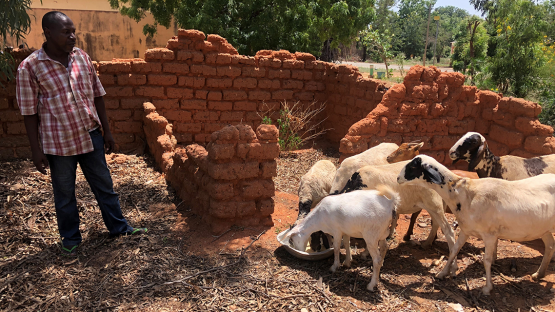GAROUA, CAMEROON – Babi Dairou lost a third of his goat herd in 2019, when a viral disease attacking small ruminants, such as sheep and goats, swept through northern Cameroon. And he was among the better off, Dairou said, as many of his neighbours lost all their animals to the devastating disease, known by its scientific name of peste de petits ruminants (PPR). But now, the goats of this factory worker and part time farmer as well as those of others in his village are safe from the disease, thanks to a mass vaccination campaign under the PPR Global Eradication Programme, supported by the IAEA, the Food and Agriculture Organization of the United Nations (FAO) and the World Organization for Animal Health.
PPR is endemic in the region – its spread is facilitated by the movement of wild animals as well as domesticated herds across borders – and despite earlier control campaigns it has returned to Cameroon. In the north, where a narrow strip of Cameroonian territory cuts into the southern edge of the Sahel, the borders with Chad to the east and Nigeria to the west are never very far away, so transboundary animal diseases can invade fast. This part of the country, known as the north and the far north, is home to 80 per cent of Cameroon’s livestock, said Gabriel Toumba, Regional Coordinator of the Livestock Development Project, a World Bank supported programme that coordinated the vaccination campaign on the ground. An average 88 per cent of small ruminants were vaccinated in each of the three years of the campaign, using vaccines produced by the National Veterinary Laboratory (LANAVET), located just 15 kilometers south of Garoua.
LANAVET produces 25 million doses of vaccines each year to fight various veterinary diseases infecting cattle, small ruminants and poultry. It performs the diagnosis and quality controls through the application of nuclear and related technologies (see The role of nuclear and related techniques in diagnosing PPR). Indeed, as a walk across its 1200 square meter plant reveals, around half its equipment has been donated by the IAEA through its technical cooperation programme and the VETLAB Network, a global network of national veterinary diagnostic laboratories promoting research and the transfer of technologies and information coordinated by the Joint FAO/IAEA Centre of Nuclear Techniques in Food and Agriculture based in Vienna, Austria.
The longstanding support by the IAEA, in partnership with FAO, has included much more: the organizations have provided training and expert advice, as well as reagents and consumables to LANAVET to carry outs its research and quality control work, said Simon Dickmu Jumbo, Director of the national laboratory’s Animal Diagnosis Department. This skills development, complemented by regular advice from the IAEA has led to the successful accreditation of the lab as ISO 17025-compliant, the only such veterinary laboratory in Central Africa. It’s been able to increase its capacity as a result, and now supports several countries in the region by exporting seven different veterinary vaccines. Farmers in Benin, Burkina Faso, Chad, Cote d’Ivoire, Gabon, Ghana and Nigeria all benefit from support by LANAVET, including regional trainings and fellowship it now offers – via the IAEA – to veterinary researchers from these countries. Besides diagnosing diseases and producing vaccines, LANAVET also performs quality control tests on veterinary drugs imported by Cameroon. This, too, uses nuclear and related technologies.








